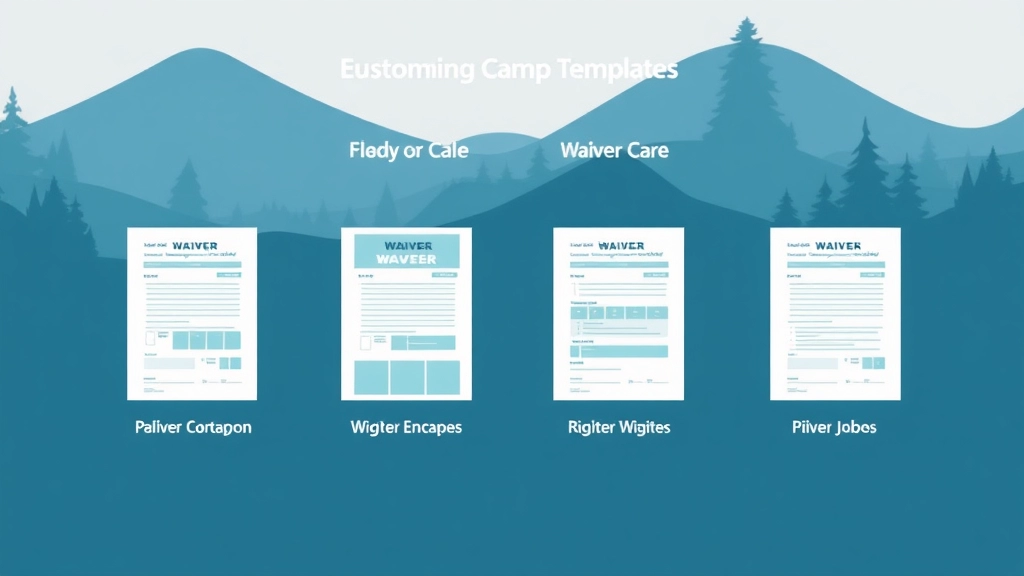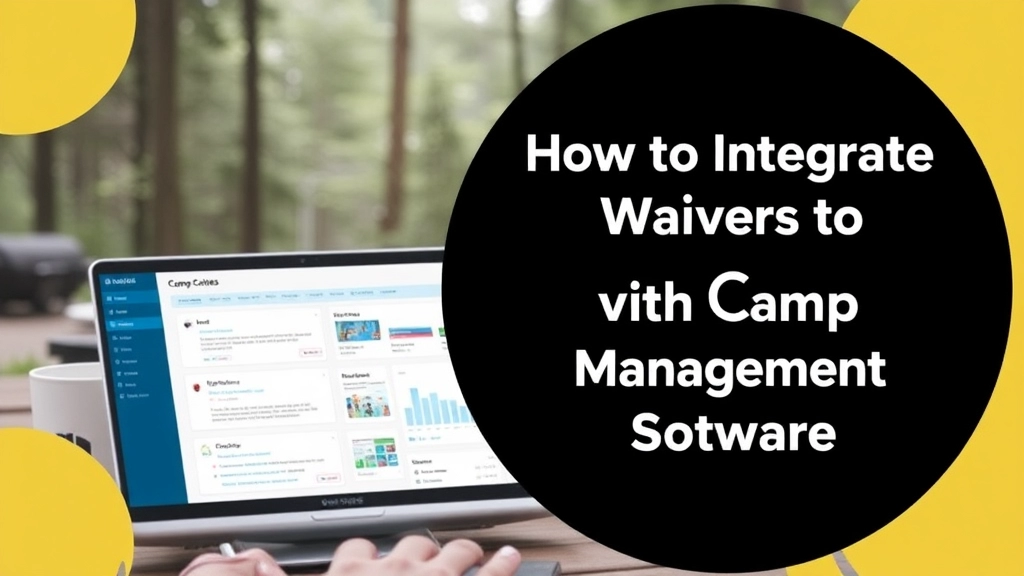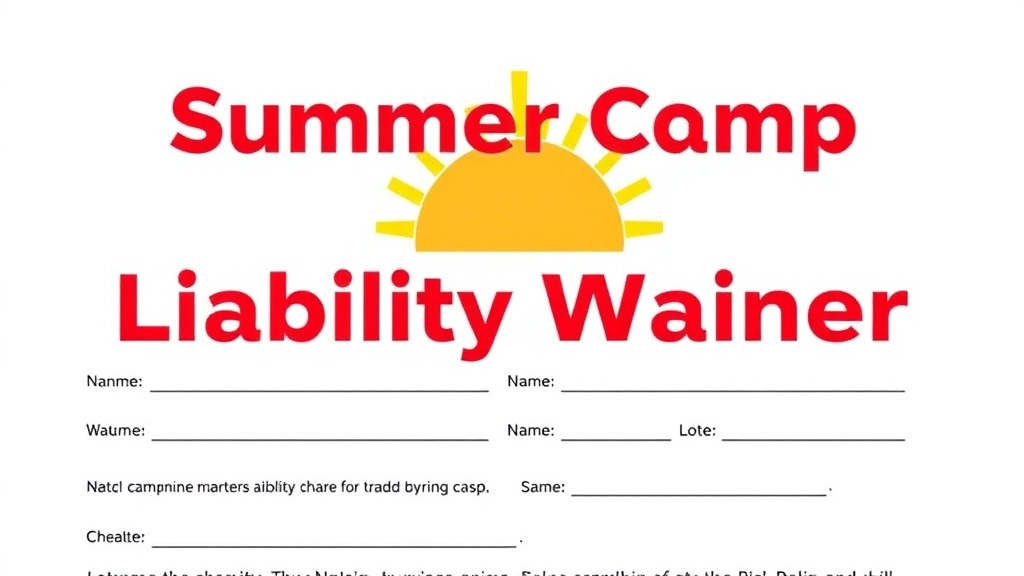Creating a Comprehensive Summer Camp Liability Waiver
Creating a comprehensive Summer Camp Liability Waiver is essential for protecting both camp organisers and participants. This guide will walk you through the key elements to include, ensuring your waiver is legally sound and easy to understand.
With the rise of digital solutions, we’ll also explore the benefits of digital waivers over traditional paper forms, making the process more efficient and accessible for everyone involved. Let’s dive into the crucial aspects of crafting a foolproof summer camp liability waiver.
How to Create a Summer Camp Liability Waiver
Alright, let’s get straight to it. You’re running a summer camp, and you need to make sure you’re covered if anything goes sideways. How do you do that? With a solid summer camp liability waiver. Trust me, you don’t want to skip this step. So, how do you create one that actually does its job?
Why You Need a Liability Waiver
First things first, why even bother? Well, accidents happen. Kids can get hurt, and parents might look to you for answers. A liability waiver helps protect your camp from legal trouble by making sure parents understand the risks involved.
Key Steps to Create a Solid Waiver
- Identify the Risks: Think about all the activities your camp offers. Swimming, hiking, arts and craftsâeach comes with its own set of risks. List them out.
- Consult a Lawyer: This is non-negotiable. You need a legal pro to help you draft a waiver that’s airtight. They know the legal jargon and the loopholes to avoid.
- Draft Clear Language: Your waiver should be easy to read. No one likes legal mumbo jumbo. Make sure it’s straightforward and explains the risks clearly.
- Include Essential Elements: Your waiver needs to cover:
- Assumption of Risk: Parents acknowledge that they understand the risks.
- Release of Liability: They agree not to sue you if something goes wrong.
- Emergency Contact Info: In case something does happen, you need to know who to call.
- Get it Signed: This might seem obvious, but you’d be surprised how often it’s overlooked. Make sure every parent signs the waiver before their kid sets foot in your camp.
Real-Life Example
Imagine this: A kid trips during a hike and breaks an arm. Without a waiver, the parents could sue you for medical expenses and more. But with a solid waiver, they’ve already agreed that they understand the risks involved. It’s a game-changer.
Checklist for Your Waiver
- Clear Language: No legal jargon
- List of Risks: Specific to your camp activities
- Assumption of Risk: Parents acknowledge understanding
- Release of Liability: Parents agree not to sue
- Emergency Contact Info: Essential for quick action
- Signature Line: Don’t forget this!
For more tips on running a successful camp, check out our Ultimate Summer Camp Schedule Template Guide and make sure your camp is both fun and safe by following our Summer Camp Transportation Safety and Convenience tips.
Key Elements to Include in a Camp Liability Waiver

Alright, let’s get straight to it.
You’re running a summer camp and want to make sure you’re covered legally.
How do you do that?
With a solid liability waiver.
But what should go into it?
Here’s the lowdown.
Clear Identification
First thing’s first.
Who’s signing this thing?
Make sure you get the full name, address, and contact info of the participant and their guardian.
Simple, but crucial.
Description of Activities
Be specific.
List out all the activities the camp offers.
From swimming to rock climbing, you want to cover all bases.
Assumption of Risk
This is a biggie.
You need to spell out that the participant understands the risks involved.
Use plain language.
No need to get all legalese.
Release of Liability
Here’s where you cover your back.
State clearly that the camp isn’t responsible for injuries or accidents.
Make it airtight.
Medical Information and Consent
You need to know about any medical conditions.
And you need permission to seek medical help if something goes south.
Emergency Contact Information
Who do you call if there’s an emergency?
Get those details.
Photo and Video Release
Planning to take photos or videos?
Get consent for that.
Signature and Date
Last but not least.
Get that signature.
And the date.
Quick Story
I remember a camp that didn’t include a photo release in their waiver.
Parents were up in arms when they saw their kids’ photos online.
Avoid that mess.
Digital vs. Paper Waivers: Pros and Cons
Alright, let’s talk about digital vs. paper waivers. This is something every camp organiser wrestles with. Should you stick with the old-school paper method or jump on the digital bandwagon? Let’s break it down.
Why the Fuss About Waivers?
Before we dive in, let’s address the elephant in the room. Why do we even need waivers? Simple. They protect you from potential legal headaches if something goes south. But choosing the right format? That’s where it gets tricky.
The Lowdown on Paper Waivers
Paper waivers have been around forever. They’re straightforward, tangible, and don’t require any tech know-how. But are they still the best option?
Pros:
- Simplicity: No need for gadgets or internet.
- Familiarity: Everyone knows how to sign a piece of paper.
- Immediate Access: You can hand them out and get them signed on the spot.
Cons:
- Storage Issues: Piles of paper can quickly become a nightmare.
- Organisation: Keeping track of who signed what can be chaotic.
- Accessibility: Hard to access if you’re not physically present.
The Scoop on Digital Waivers
Now, let’s talk digital. With everything going online, digital waivers are becoming the norm. But are they all they’re cracked up to be?
Pros:
- Convenience: Sign anytime, anywhere. No need to be present.
- Storage: No more filing cabinets. Everything’s in the cloud.
- Organisation: Easy to track and manage. You can search and sort with a few clicks.
- Integration: Can be synced with camp management software for seamless operations.
Cons:
- Tech Issues: Not everyone is tech-savvy. Some parents might struggle.
- Access: Requires internet and a device.
- Security: Digital data can be hacked if not properly secured.
Real Talk: What’s Right for You?
So, which one should you go for? It really depends on your camp’s needs and your audience. Here’s a quick rundown to help you decide:
- Small Camps: If you’re running a small, local camp and your audience isn’t tech-savvy, paper might be the way to go.
- Tech-Savvy Audience: If your campers’ parents are comfortable with tech, digital waivers can save you tons of time and hassle.
- Hybrid Approach: Consider offering both options. This way, you cater to everyone and cover all bases.
My Two Cents
From my experience, digital waivers are a game-changer, especially if you’re juggling multiple activities and a large number of campers. The convenience and organisation they offer are hard to beat. But, don’t ditch paper waivers entirely. They’re a solid backup and can be a lifesaver in tech glitches.
For more tips on managing your camp efficiently, check out our efficient summer camp budget template. And if you’re looking for fun activities to keep campers engaged, our summer camp daily schedule has you covered.
Customising Waiver Templates for Different Camp Activities

Ever wondered why your camp waivers feel like one-size-fits-all?
Yeah, me too.
Let’s dive into customising those templates so they actually fit the activities you’re offering.
Why Customise?
First off, different activities come with different risks.
A hiking trip isn’t the same as a swimming lesson.
Parents need to know what they’re signing up for.
And you need to cover your back.
Key Elements to Customise
- Activity-Specific Risks
- Got rock climbing? Mention falls, equipment failure, and physical strain.
- Running a cooking class? Talk about burns, cuts, and food allergies.
- Age Appropriateness
- Tailor the language to fit the age group.
- Younger kids? Keep it simple.
- Teens? You can be a bit more detailed.
- Skill Levels
- Beginners vs. advanced participants.
- Make it clear what experience is needed.
Example Time
Imagine you’re running a kayaking camp.
Your waiver should cover:
- Water Safety: Drowning risks, life jacket requirements.
- Weather Conditions: Sudden changes, storms.
- Physical Exertion: Arm strain, muscle fatigue.
Real Talk: Parents’ Concerns
Parents worry about their kids getting hurt.
They want to know you’ve thought of everything.
So, spell it out.
Make it clear what the risks are, and how you’re mitigating them.
Keep it Engaging
Don’t just copy-paste legal jargon.
Use plain language.
Break it down into bullet points.
Make it easy for parents to skim through and understand.
Pro Tips
- Use Headers and Subheaders: Makes it easy to navigate.
- Highlight Important Info: Bold the key points.
- Include Real-Life Examples: Share a quick story of how you handled a previous incident.
Legal Considerations When Drafting Liability Waivers
Alright, let’s get down to it. When it comes to drafting liability waivers for your summer camp, you’ve got to nail it. Why? Because the last thing you want is a legal headache when you should be focusing on creating unforgettable experiences for the kids. So, what are the key legal considerations you need to keep in mind?
What Keeps You Up at Night?
You’re probably asking yourself: “What if a kid gets hurt? Can I be sued? How do I protect my camp legally?” These are real worries, and it’s crucial to address them head-on. Here’s how you can make sure your waiver stands up in court and keeps you covered.
Understand Your Local Laws
First off, know that laws vary. What works in one state or country might not cut it in another. Research local regulations and maybe even consult a legal expert. You don’t want to copy-paste a waiver template from the internet and call it a day. That’s just asking for trouble.
- Check local regulations: Different states/countries have different rules.
- Consult a legal expert: Don’t wing it; get professional advice.
- Adapt templates: Use them as a guide, not gospel.
Clear and Specific Language
Legal jargon? No thanks. Your waiver needs to be clear and straightforward. Parents should understand exactly what they’re signing. If it’s too complex, it won’t hold up in court.
- Be specific: Detail the activities and potential risks.
- Use plain language: Avoid legalese to ensure clarity.
- Include examples: Real-world scenarios can help clarify risks.
Comprehensive Risk Disclosure
You need to spell out the risks involved. If kids are going rock climbing, parents should know the potential dangers. The more transparent you are, the better.
- List all activities: Be thorough in describing what the kids will be doing.
- Outline risks: Don’t sugarcoat it. Parents need the full picture.
- Use bullet points: Make it easy to read and understand.
Assumption of Risk
Make it crystal clear that by signing the waiver, parents acknowledge the risks and agree not to hold the camp liable. This is your safety net.
- Explicit statement: Parents must acknowledge the risks.
- No liability: Make it clear that the camp isn’t responsible for injuries.
- Highlight this section: Use bold text or a separate header.
Parental Consent
For minors, you need parental consent. This isn’t just a formality; it’s a legal necessity. Ensure the waiver includes a section where parents can sign off.
- Include a consent section: Parents must sign and date it.
- Verify signatures: Make sure the person signing is legally allowed to do so.
- Keep records: Store these waivers securely.
Regular Updates
Laws change, and so do camp activities. Your waiver should be a living document, updated regularly to reflect new activities or legal requirements.
- Annual review: Update your waiver at least once a year.
- Legal check: Have a lawyer review changes.
- Communicate updates: Inform parents of any changes.
Real-World Example
Imagine you’re running a summer camp with activities like kayaking and rock climbing. You’ve done your research, consulted a legal expert, and drafted a waiver that clearly outlines the risks. Parents sign off, understanding that while their kids will have a blast, there are inherent risks involved. One day, a camper twists an ankle while hiking. Thanks to your well-drafted waiver, you’re legally covered, and the parents knew what they were signing up for.
How to Integrate Waivers with Camp Management Software

Alright, let’s talk about integrating waivers with camp management software.
Ever found yourself buried in a mountain of paper waivers? Yeah, not fun.
So, how do we make this whole waiver thing less of a headache?
Why Integrate Waivers with Software?
First off, why bother integrating waivers with software?
Because it saves you time and sanity.
- Automated Tracking: No more hunting down missing forms.
- Instant Access: Pull up any waiver, anytime, anywhere.
- Reduced Errors: Less manual entry means fewer mistakes.
Steps to Integrate Waivers
Now, let’s break it down.
- Choose the Right Software:
- Look for camp management software that supports waiver integration.
- Check if it has features like automated reminders and easy access.
- Customise Your Waiver:
- Make sure your waiver template fits the software’s format.
- Add fields for electronic signatures, dates, and any specific details you need.
- Upload and Test:
- Upload your customised waiver into the software.
- Test it out. Make sure it’s easy to fill out and submit.
- Train Your Staff:
- Show your team how to use the software.
- Run through a few scenarios so everyone’s on the same page.
- Communicate with Parents:
- Let parents know they’ll be filling out waivers online.
- Send out clear instructions and be ready to help if they hit any snags.
Pros and Cons of Digital Waivers
Let’s keep it real. Digital waivers aren’t all sunshine and rainbows.
Pros
- Convenience: Fill out anywhere, anytime.
- Eco-Friendly: Save a tree or two.
- Efficiency: Faster processing and less clutter.
Cons
- Tech Issues: Not everyone’s a tech whiz.
- Access: Some might struggle without reliable internet.
Real Talk: What’s the Best Approach?
Here’s a story for you.
Last summer, our camp switched to digital waivers.
We thought it’d be smooth sailing.
But guess what?
We had parents calling in, confused about the process.
So, we tweaked our approach.
Tips
- Clear Instructions: Step-by-step guides work wonders.
- Support: Be ready to assist with any hiccups.
- Reminders: Automated emails to nudge forgetful folks.
Best Practices for Ensuring Waiver Completion Rates
Alright, let’s talk about something that keeps camp organisers up at night: getting those liability waivers signed. You know it’s crucial, but parents sometimes treat it like spam email. So, how do we make sure everyone signs on the dotted line?
Why Do Parents Drag Their Feet?
First, let’s address the elephant in the room. Why do parents hesitate or forget to sign waivers? Here are some real worries they have:
- Confusion: “What exactly am I signing?”
- Time: “I don’t have time for this right now.”
- Forgetfulness: “I’ll do it later… and then they forget.”
Make It Easy and Clear
You want to make this process as smooth as a summer breeze. Here’s how:
- Simplify the Language: Avoid legal jargon. Keep it simple and straightforward.
- Clear Instructions: Provide step-by-step instructions. If it’s digital, guide them through the process.
- Highlight Importance: Explain why the waiver is crucial for their child’s safety and the camp’s operation.
Multiple Touchpoints
Parents are busy, so you need to remind themâgently but persistently. Here are some touchpoints:
- Email Reminders: Send a series of emails. Start with a âheads upâ email, followed by reminders as the deadline approaches.
- Text Messages: A quick text can be more effective than an email. Keep it short and sweet.
- Camp Website: Have a prominent section on your website where parents can easily access and sign the waiver.
Incentivise Completion
Sometimes a little nudge goes a long way. Here’s how you can incentivise:
- Early Bird Discounts: Offer a small discount for early completion.
- Priority Check-In: Parents who complete waivers early get a faster check-in process on the first day of camp.
Leverage Technology
Use tech to your advantage. Here are some ways to integrate waivers with your camp management software:
- Automated Reminders: Set up automated email and text reminders.
- Mobile-Friendly Forms: Ensure the waiver can be signed on a smartphone.
- Integration: Sync the waiver process with your registration system so it’s one seamless flow.
Monitor and Follow-Up
Keep an eye on who hasn’t completed their waivers:
- Dashboard: Use a dashboard to track waiver completion rates.
- Personal Follow-Up: For those lagging behind, a personal call or email can make a difference.
Real-Life Example
Last summer, we had a parent who always forgot to sign the waiver. We sent her a friendly reminder text, and she signed it within minutes. Sometimes, it’s just about being in the right place at the right time.
Managing Signed Waivers: Storage and Access Solutions

Got a stack of signed waivers piling up?
Yeah, it’s a common headache for camp organisers. You need to keep them safe, accessible, and well-organised. But how?
Let’s dive into some practical solutions.
Digital Storage: The Modern Way
Going digital is a game-changer. Here’s why:
- Easy Access: Access any waiver with a few clicks.
- Space Saver: No more bulky filing cabinets.
- Backup: Cloud storage means your waivers are safe from physical damage.
Top Digital Storage Options:
- Cloud Services: Google Drive, Dropbox, or OneDrive.
- Camp Management Software: Many come with built-in waiver storage.
Paper Storage: The Old-School Method
If you prefer paper, no worries. Just make sure it’s done right.
- Organise by Date/Activity: Keep things easy to find.
- Secure Storage: Use fireproof, waterproof cabinets.
- Backup Copies: Always have digital scans as a backup.
Hybrid Approach: Best of Both Worlds
Not ready to go fully digital? Combine both methods.
- Scan and Store: Keep a digital copy of each paper waiver.
- Physical Backup: Retain originals in a secure location.
Access Solutions: Who Needs What?
Not everyone needs access to waivers. Here’s how to manage it:
- Restricted Access: Only authorised personnel should access waivers.
- Audit Trails: Keep logs of who accessed what and when.
- Password Protection: For digital files, always use strong passwords.
Real Talk: Why It Matters
Imagine a parent questioning a waiver. You need that document fast.
Or worse, a legal issue arises.
Having a solid storage and access system can save you a ton of stress.
Quick Tips:
- Regular Audits: Check your storage system regularly.
- Training: Make sure staff know how to access and store waivers properly.
- Updates: Keep software and storage solutions up-to-date.
Tips for Communicating Waiver Requirements to Parents
Alright, let’s talk about something every camp organiser worries about: getting parents to understand and complete those liability waivers. It’s not just about legal mumbo jumbo; it’s about ensuring everyone’s on the same page for a safe and fun summer camp experience. So, how do we make this happen without turning it into a chore for everyone involved? Here are some solid tips to get you started.
Addressing Common Concerns
First off, let’s get real about the questions and worries parents have:
- “Why do I need to sign this?” Parents need to know why the waiver is crucial. It’s not just a formality; it’s about protecting their kids and the camp.
- “Is my child really safe?” They want to know that their child’s safety is your top priority. Reassure them with examples of your safety protocols.
- “What if I don’t understand the legal jargon?” Many parents are intimidated by legal language. Make it simple and clear.
Clear and Concise Communication
When it comes to communicating waiver requirements, keep it straightforward and engaging. Here’s how:
- Use Plain Language: Skip the legalese. Explain what the waiver covers in simple terms.
- Highlight Key Points: Use bullet points or bold text to highlight the most important aspects of the waiver.
- Visual Aids: Sometimes a picture or a quick video can explain things better than text. Consider creating a short video that walks parents through the waiver.
Multiple Channels of Communication
Don’t rely on just one method to get the word out. Use a mix of channels to ensure every parent gets the message:
- Emails: Send out clear, concise emails with all the necessary details.
- Social Media: Use your camp’s social media platforms to remind parents about the waiver.
- Camp Website: Have a dedicated section on your website where parents can easily find and understand the waiver requirements.
- In-Person Meetings: If possible, hold a pre-camp meeting where you can explain the waiver and answer any questions.
Making It Easy to Complete
Parents are busy. The easier you make it for them to complete the waiver, the better your completion rates will be:
- Digital Options: Offer an online waiver that can be signed electronically. This is quicker and more convenient for most parents.
- Step-by-Step Guide: Provide a step-by-step guide on how to fill out the waiver. Make it foolproof.
- Reminders: Send gentle reminders as the camp start date approaches. A friendly nudge can go a long way.
Real-Life Examples
Imagine this: You’re at a coffee shop with a friend who’s a parent. They ask, “Why do I need to sign this waiver?” You could say, “Look, it’s like this. Remember when we went ziplining and had to sign a waiver? It’s the same thing. It’s just to make sure everyone knows the risks and agrees to them. Plus, it helps us keep your kids safe by knowing any medical conditions or allergies.”
Common Mistakes to Avoid in Camp Liability Waivers
Alright, let’s get real for a second.
Creating a camp liability waiver can be a minefield.
Miss one detail, and you could be in for a world of trouble.
So, what are the common mistakes to avoid?
Let’s dive in.
Not Being Specific Enough
Your waiver needs to be crystal clear.
Vague language? That’s a no-go.
You need to outline every activity and potential risk.
Parents should know exactly what they’re signing up for.
Legal Jargon Overload
Don’t try to impress with fancy legal terms.
Keep it simple and straightforward.
If parents can’t understand it, they won’t trust it.
Use plain English.
Skipping the Legal Review
This is a biggie.
Always get a legal pro to review your waiver.
Think you can handle it yourself?
Think again.
A lawyer can spot gaps you’d never even think of.
Forgetting to Update
Your camp evolves, and so should your waiver.
New activities? Update the waiver.
New regulations? Update the waiver.
Keep it current, or it’s useless.
Not Including Emergency Contact Info
Sounds basic, right?
But you’d be surprised how many waivers skip this.
Always include a section for emergency contacts.
It’s a must.
Ignoring the Digital Option
Paper waivers are so last decade.
Digital waivers are easier to track and manage.
Plus, parents can sign them on the go.
Don’t ignore this option.
Not Getting Parental Consent
Seems obvious, but it’s worth mentioning.
You need explicit consent from parents or guardians.
No exceptions.
Failing to Store Waivers Properly
Once signed, waivers need to be stored securely.
Don’t just toss them in a drawer.
Use a reliable storage system, preferably digital.
Poor Communication
Make sure parents know why the waiver is important.
Explain the risks and the need for the waiver.
Clear communication builds trust.
Overloading with Information
Don’t overwhelm parents with too much info.
Stick to the essentials.
If it’s too long, they might not read it.
Examples to Ponder
Imagine a parent signs a waiver without fully understanding it.
Their child gets injured.
Now you’re facing a lawsuit.
All because the waiver wasn’t clear or specific enough.
Or think about a camp that added a new rock climbing activity but didn’t update their waiver.
An accident happens, and suddenly, the waiver doesn’t cover it.
You see where this is going.
Final Thoughts
Avoiding these common mistakes can save you a lot of headaches.
Keep your waiver clear, specific, and up-to-date.
Get it reviewed by a legal expert.
And always, always communicate effectively with parents.
Got it?
Good.
Now go make that waiver bulletproof.
Looking for more tips on running a successful camp? Check out our Ultimate Guide to Summer Camp Layout Design and make sure your camp is set up for success. Also, don’t miss our Ultimate Guide to Must-Have Items for Summer Camp to ensure you’re fully prepared for the season.
FAQs on Summer Camp Liability Waiver
What is a summer camp liability waiver?
A summer camp liability waiver is a legal document that participants and their guardians sign to acknowledge the risks involved in camp activities and to release the camp from liability for injuries or accidents.
Why is a liability waiver important for summer camps?
A liability waiver is crucial because it helps protect the camp from legal claims in case of injuries or accidents. It ensures that participants and their guardians are aware of the risks involved in camp activities.
What key elements should be included in a camp liability waiver?
Key elements include:
- Clear Identification: Full name, address, and contact info of the participant and guardian.
- Description of Activities: A detailed list of all camp activities.
- Assumption of Risk: A statement that the participant understands the risks involved.
- Release of Liability: A clause stating the camp isn’t responsible for injuries or accidents.
- Medical Information and Consent: Information on medical conditions and consent to seek medical help.
- Emergency Contact Information: Details of who to contact in an emergency.
- Photo and Video Release: Consent for taking and using photos or videos.
- Signature and Date: Signature of the participant or guardian and the date.
How can I customize waiver templates for different camp activities?
Customize waiver templates by specifying activity-specific risks, tailoring language to age appropriateness, and clarifying required skill levels. For example, a kayaking camp waiver should cover water safety, weather conditions, and physical exertion.
Why should I integrate waivers with camp management software?
Integrating waivers with camp management software saves time and reduces errors. Benefits include automated tracking, instant access to waivers, and fewer manual entries.
What are the steps to integrate waivers with camp management software?
Steps include:
- Choose the Right Software: Ensure it supports waiver integration and has features like automated reminders.
- Customize Your Waiver: Fit the waiver template to the software’s format and add necessary fields.
- Upload and Test: Upload the waiver and test its usability.
- Train Your Staff: Educate your team on using the software.
- Communicate with Parents: Inform parents about the online waiver process and provide assistance if needed.
What are the pros and cons of digital waivers?
Pros
- Convenience: Fill out waivers anytime, anywhere.
- Eco-Friendly: Reduces paper usage.
- Efficiency: Faster processing and less clutter.
Cons
- Tech Issues: Not everyone is tech-savvy.
- Access: Some may struggle without reliable internet.
How should I manage signed waivers?
Manage waivers by choosing between digital and paper storage or a hybrid approach. Ensure easy access, secure storage, and proper organization. For digital waivers, use cloud services or camp management software. For paper waivers, use fireproof, waterproof cabinets and keep digital backups.
Who should have access to signed waivers?
Only authorized personnel should access waivers. Implement restricted access, audit trails, and password protection for digital files to ensure security.
Why is it important to have a solid storage and access system for waivers?
Having a reliable storage and access system is crucial for quickly retrieving waivers in case of parental queries or legal issues. It ensures that all documents are safe, organized, and easily accessible.
References
-
How to Write a Liability Waiver for Your Summer Camp
-
Customizing Waivers for Different Activities
-
Integrating Waivers with Camp Management Software

